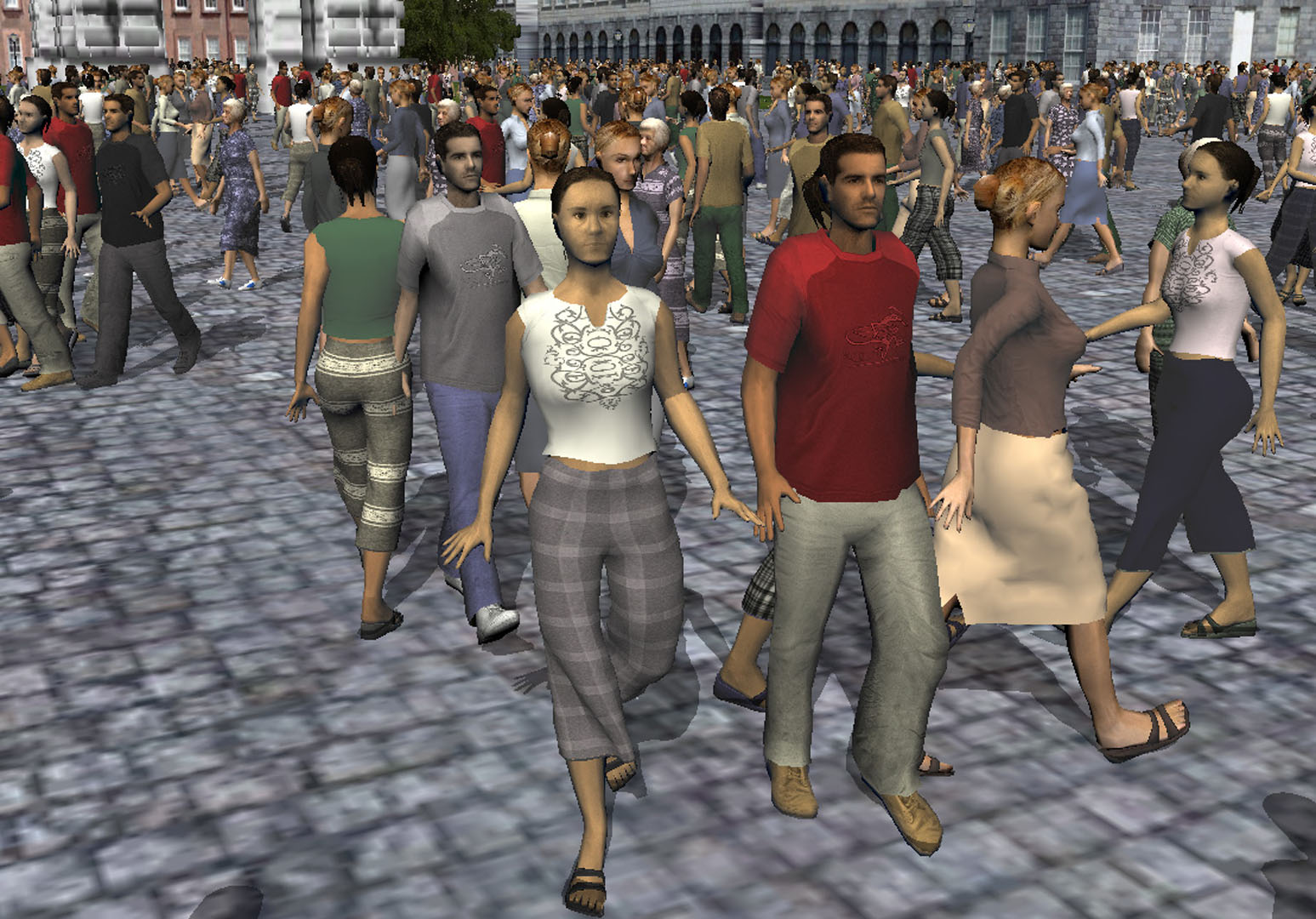“Clone attack! Perception of crowd variety” by McDonnell, Larkin, Dobbyn, Collins and O’Sullivan
Conference:
Type(s):
Title:
- Clone attack! Perception of crowd variety
Presenter(s)/Author(s):
Abstract:
When simulating large crowds, it is inevitable that the models and motions of many virtual characters will be cloned. However, the perceptual impact of this trade-off has never been studied. In this paper, we consider the ways in which an impression of variety can be created and the perceptual consequences of certain design choices. In a series of experiments designed to test people’s perception of variety in crowds, we found that clones of appearance are far easier to detect than motion clones. Furthermore, we established that cloned models can be masked by color variation, random orientation, and motion. Conversely, the perception of cloned motions remains unaffected by the model on which they are displayed. Other factors that influence the ability to detect clones were examined, such as proximity, model type and characteristic motion. Our results provide novel insights and useful thresholds that will assist in creating more realistic, heterogeneous crowds.
References:
1. Arikan, O. 2006. Compression of motion capture databases. ACM Transactions on Graphics 25, 3, 890–897. Google ScholarDigital Library
2. Beardsworth, T., and Buckner, T. 1981. The ability to recognize oneself from a video recording of ones movements without seeing ones body. Bulletin of the Psychonomic Society 18, 1, 19–22.Google ScholarCross Ref
3. Cutting, J., and Kozlowski, L. 1977. Recognizing friends by their walk: Gait perception without familiarity cues. Bulletin of the Psychonomic Society 9, 5, 353–356.Google ScholarCross Ref
4. de Heras Ciechomski, P., Schertenleib, S., Maïm, J., and Thalmann, D. 2005. Real-time shader rendering for crowds in virtual heritage. In Proceedings of the 6th international Symposium on Virtual Reality, Archeology and Cultural Heritage (VAST 2005), 1–8. Google ScholarDigital Library
5. de Heras Ciechomski, P., Schertenleib, S., Maïm, J., and Thalmann, D. 2005. Reviving the roman odeon of aphrodisias: Dynamic animation and variety control of crowds in virtual heritage. In VSMM: Virtual Systems and Multimedia, 601–610.Google Scholar
6. Dobbyn, S., Hamill, J., O’Conor, K., and O’Sullivan, C. 2005. Geopostors: a real-time geometry / impostor crowd rendering system. In SI3D ’05: Proceedings of the 2005 symposium on Interactive 3D graphics and games, 95–102. Google ScholarDigital Library
7. Dobbyn, S., McDonnell, R., Kavan, L., Collins, S., and O’Sullivan, C. 2006. Clothing the masses: Real-time clothed crowds with variation. In Eurographics Short Papers, 103–106.Google Scholar
8. Gosselin, D., Sander, P., and Mitchell, J. 2005. Drawing a crowd. ShaderX3, 505–517.Google Scholar
9. Hamill, J., McDonnell, R., Dobbyn, S., and O’Sullivan, C. 2005. Perceptual evaluation of impostor representations for virtual humans and buildings. Computer Graphics Forum (Eurographics 2005) 24, 3, 623–633.Google Scholar
10. Harrison, J., Rensink, R. A., and Van De Panne, M. 2004. Obscuring length changes during animated motion. ACM Transactions on Graphics 23, 3, 569–573. Google ScholarDigital Library
11. Hodgins, J., O’Brien, J., and Tumblin, J. 1998. Perception of human motion with different geometric models. IEEE Transactions on Visualization and Computer Graphics 4, 4, 307–316. Google ScholarDigital Library
12. Johansson, G. 1973. Visual perception of biological motion and a model for its analysis. Perception and Psychophysics 14, 2, 201–211.Google ScholarCross Ref
13. Kovar, L., Gleicher, M., and Pighin, F. 2002. Motion graphs. ACM Transactions on Graphics 21, 3, 473–482. Google ScholarDigital Library
14. Lee, J., Chai, J., and Reitsma, P. 2002. Interactive control of avatars animated with human motion data. International Conference on Computer Graphics and Interactive Techniques, 491–500. Google ScholarDigital Library
15. Maïm, J., Haegler, S., Yersin, B., Mueller, P., Thalmann, D., and Vangool, L. 2007. Populating ancient pompeii with crowds of virtual romans. In Proceedings of the 8th International Symposium on Virtual Reality, Archaeology and Cultural Heritage (VAST 2007), 26–30. Google ScholarCross Ref
16. McDonnell, R., Dobbyn, S., and O’Sullivan, C. 2005. LOD human representations: A comparative study. Proceedings of the First International Workshop on Crowd Simulation, 101–115.Google Scholar
17. McDonnell, R., Dobbyn, S., Collins, S., and O’Sullivan, C. 2006. Perceptual evaluation of LOD clothing for virtual humans. In Proceedings of the 2006 ACM SIGGRAPH/Eurographics Symposium on Computer Animation, 117–126. Google ScholarDigital Library
18. McDonnell, R., Jörg, S., Hodgins, J. K., Newell, F., and O’Sullivan, C. 2007. Virtual shapers & movers: form and motion affect sex perception. In APGV ’07: Proceedings of the 4th symposium on Applied perception in graphics and visualization, 7–10. Google ScholarDigital Library
19. Pettré, J., de Heras Ciechomski, P., Maïm, J., Yersin, B., Laumond, J.-P., and Thalmann, D. 2006. Real-time navigating crowds: Scalable simulation and rendering. Computer Animation and Virtual Worlds (CASA 2006) 17, 445–455. Google ScholarCross Ref
20. Reitsma, P., and Pollard, N. 2003. Perceptual metrics for character animation: Sensitivity to errors in ballistic motion. ACM Transactions on Graphics 22, 3, 537–542. Google ScholarDigital Library
21. Tecchia, F., Loscos, C., and Chrysanthou, Y. 2002. Visualizing crowds in real-time. Computer Graphics Forum (Eurographics 2002) 21, 4, 753–765.Google Scholar
22. Thalmann, D., O’Sullivan, C., Yersin, B., Maïm, J., and McDonnell, R. 2007. Populating virtual environments with crowds. In Eurographics Tutorials, vol. 1, 25–124.Google Scholar
23. Ulicny, B., and Thalmann, D. 2002. Towards interactive real-time crowd behavior simulation. Computer Graphics Forum 21, 4, 767–775.Google ScholarCross Ref
24. Wang, J., and Bodenheimer, B. 2004. Computing the duration of motion transitions: an empirical approach. In Proceedings of the 2004 ACM SIGGRAPH/Eurographics Symposium on Computer Animation, 335–344. Google ScholarDigital Library




